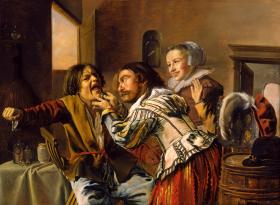
The elevation of scenes of daily life as subjects worthy of artistic interest is primarily a phenomenon of the early seventeenth century. It was in Haarlem, Molenaer’s hometown, that many innovations in subject matter first took hold in seventeenth-century Dutch art. Interestingly, these changes occurred at the same moment when the young Dutch Republic began to assert its importance on the world stage through commerce.
One of the earliest dated pictures by Molenaer, The Dentist points to his probable training in the workshops of both Frans and Dirck Hals. In comparable works by Frans Hals, the figures’ animated actions and lively expressions both engage and amuse the viewer. Molenaer’s grimacing young patient makes a similar impression, enhanced, at least in the eyes of the Protestant Dutch, by his misplaced trust in the rosary he clutches. His prayers seem to have little effect on the pain he suffers at the hand of the fancifully dressed dentist. Dentists, who were routinely portrayed as quacks during the period, had a reputation for extracting money as well as teeth from unsuspecting patients.
Molenaer was a prolific and imaginative artist whose works vary greatly in quality and style. Among the diverse subjects he painted are peasant scenes, proverbs and allegories, portraits, religious narratives, and elegant merry companies. In many respects, he was the true predecessor of Jan Steen. By 1636, the year he married the painter Judith Leyster and moved to Amsterdam, he had become a mature and respected master, living up to the promise evident in The Dentist.

